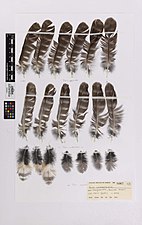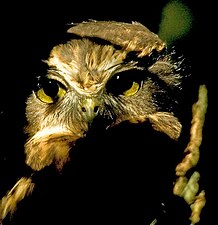Morepork
| Morepork | |
|---|---|

| |
| Morepork in New Zealand | |
| Scientific classification | |
| Domain: | Eukaryota |
| Kingdom: | Animalia |
| Phylum: | Chordata |
| Class: | Aves |
| Order: | Strigiformes |
| Family: | Strigidae |
| Genus: | Ninox |
| Species: | N. novaeseelandiae
|
| Binomial name | |
| Ninox novaeseelandiae (Gmelin, JF, 1788)
| |
| Subspecies | |
|
2 extant, 1 extinct (see text) | |
The morepork (Ninox novaeseelandiae), also known by numerous other onomatopoeic names (such as boobook, mopoke or ruru),[3] is a smallish, brown owl species found in New Zealand, and to the northwest, on Norfolk Island, an Australian territory. It was also, formerly, found on Lord Howe Island.[3] Three subspecies of the morepork are recognised, one of which is extinct and another that exists only as a hybrid population.
First described by Johann Friedrich Gmelin in 1788, the morepork was thought to be the same species as the Australian boobook (N. boobook), native to Australia, Timor-Leste and New Guinea, something that endured for nearly two hundred years, until 1999. Similarly, it was also considered the same as the Tasmanian boobook (N. leucopsis) until 2022.
The morepork has dark-brown plumage with prominent pale spots and golden-yellow eyes. Like most strigiformes, the species is generally nocturnal, though may be crepuscular at times (or active at dawn and dusk), retiring to roost in secluded spots within the branches of trees. The morepork feeds on larger insects and small vertebrates, hunting by pouncing on them from tree perches. As with all owls, the morepork has supreme night vision and excellent hearing, able to locate a tiny lizard or rodent from many metres above and away. They then stealthily approach their targeted prey with near-silent flight, without flapping their wings, the prey often not even aware they are being pursued.
The International Union for Conservation of Nature (IUCN) has assessed the morepork's population and its potential for decline, and ranked the species as being of least concern (not currently at-risk), owing to its presently large range and apparently stable population.[1]
Taxonomy
The morepork was
Three subspecies are recognised:[8]
- N. n. novaeseelandiae (Gmelin, JF, 1788) – North and South Islands of New Zealand and Stewart Island
- N. n. undulata (Latham, 1801) – the Norfolk boobook, Norfolk Island (east of Australia)
- † N. n. albaria Ramsay, EP, 1888 – the Lord Howe boobook, Lord Howe Island (east of Australia) extinct
Both
Janette Norman and colleagues tested the cytochrome b DNA of three subspecies (as well as the powerful and rufous owls) to ascertain whether the closest relative was used in breeding with the last surviving female of the Norfolk boobook. They discovered that although the Norfolk boobook was similar in plumage to the Tasmanian boobook, it was genetically much closer to the New Zealand subspecies. In fact, the two were so close genetically that they considered whether the Norfolk boobook should be recognised as a separate taxon at all, although they conceded the two were easily distinguishable in appearance, so maintained the three as subspecies; the Tasmanian boobook only diverged by 2.7% from the other two, while the powerful and rufous owls diverged by 4.4% from each other.[12] Leading from this, the Australian boobook was split from the Tasmanian boobook and morepork in volume 5 of the Handbook of the Birds of the World; however, several authors, including Les Christidis and Walter Boles, contested that the data had been misinterpreted from the Norman study, which had not sampled any Australian mainland boobooks at all. They treated the three taxa (southern, Tasmanian boobooks, and moreporks) as a single species.[13]
Examining both morphological and genetic (cytochrome b) characters, Michael Wink and colleagues concluded that the Australian boobook was distinct from the morepork, as was the Tasmanian boobook, which is raised to species status as Ninox leucopsis.[14] In 2022, the International Ornithological Congress reclassified the Tasmanian boobook and morepork as distinct species.[15][16]
Description

The morepork is 26 to 29 cm (10 to 11.5 in) long, with the female slightly larger than the male. Females are slightly heavier at 170–216 g (6.0–7.6 oz) compared with the male's 140–156 g (4.9–5.5 oz).[17] The morepork has generally dark brown head and upperparts, with pale brown spots on head and neck and white markings on the rest of the upperparts, with a pale yellow-white supercilium (eyebrow), dark brown ear coverts, and buff cheeks.[18] The eyes are yellow to golden-yellow.[19] The feathers of the chin and throat are buff with dark brown shafts. The feathers of the underparts are mostly dark brown with buff and white spots and streaks, with the larger markings on the belly making it look paler overall. The upper tail is dark brown with lighter brown bars.[18] The cere and bill is pale blue-grey with a black cutting edge. The feet are orange or yellow with blackish claws.[19]
Young moreporks do not attain adult plumage properly until their third or fourth year.[18] The tips of juvenile's feathers are white and fluffy, remnants of the nestlings' down. These are worn away over time, persisting longest on the head. The feathers of the head, neck, and underparts are fluffier overall. Their plumage is a darker and more greyish brown overall than that of adults.[20]
Distribution and habitat
In New Zealand's North Island, it is common from
In New Zealand, it primarily inhabits forests dominated by Podocarpus, Nothofagus, Metrosideros, and other hardwoods, up to the alpine tree line. On Norfolk Island, it lives in forests of Norfolk Island pine (Araucaria heterophylla).[22]
Behaviour
They are usually seen singly, in pairs, or in small family groups of an adult pair and up to three young.
Swamp harriers could feasibly prey on young moreporks.[18]
During the day, moreporks sleep in roosts. Although mainly
Breeding

Moreporks nest anywhere the trees are large enough to have hollows.[22]
Feeding
Although their main hunting technique is perch-and-pounce, they are agile birds with a swift, goshawk-like wing action and the ability to maneuver rapidly when pursuing prey or hawking for insects.
They hunt a variety of animals – mainly large invertebrates including scarab and
Conservation status
A widespread and generally common species, morepork is listed as being a
Gallery
- Morepork (ruru)
-
Morepork in Warkworth, New Zealand
-
Morepork resting in a garage
-
Display of feathers atAuckland museum
-
Ruru nestling at Remutaka Forest Park, New Zealand
-
Morepork at Maungatautari, New Zealand
-
Morepork at Kiwi Birdlife Park, Queenstown, New Zealand
References
- ^ . Retrieved 12 November 2021.
- ^ "Appendices | CITES". cites.org. Retrieved 2022-01-14.
- ^ ISBN 978-0-7566-9862-1.
- ^ Gmelin, Johann Friedrich (1788). Systema naturae per regna tria naturae : secundum classes, ordines, genera, species, cum characteribus, differentiis, synonymis, locis (in Latin). Vol. 1, Part 1 (13th ed.). Lipsiae [Leipzig]: Georg. Emanuel. Beer. p. 296.
- ^ Latham, John (1781). A General Synopsis of Birds. Vol. 1, Part 1. London: Printed for Leigh and Sotheby. pp. 149–150, No. 39.
- ^ Peters, James Lee, ed. (1940). Check-List of Birds of the World. Vol. 4. Cambridge, Massachusetts: Harvard University Press. p. 140.
- ^ Hodgson, Brian Houghton (1837). "Indication of a new genus belonging to the Strigine family, with description of the new species and type". Madras Journal of Literature and Science. 5: 23–25.
- ^ Rasmussen, Pamela, eds. (August 2022). "Owls". IOC World Bird List Version 12.2. International Ornithologists' Union. Retrieved 10 December 2022.
- ^ Mees, Gerlof Fokko (1964). "A revision of the Australian owls (Strigidae and Tytonidae)". Zoologische Verhandelingen. 65: 3–62.
- doi:10.1071/MU943003.
- ISBN 9780643104112.
- .
- ISBN 978-0-643-06511-6.
- ISBN 9781408108840.
- PMID 28017857.
- ^ "Owls – IOC World Bird List". Retrieved 2022-08-24.
- ISBN 9781408108840.
- ^ a b c d Higgins 1999, p. 867.
- ^ a b Higgins 1999, p. 869.
- ^ Higgins 1999, p. 868.
- ^ Higgins 1999, p. 855.
- ^ a b Higgins 1999, p. 854.
- ^ "Appendices I, II and III". CITES. 22 May 2009. Archived from the original on 17 March 2010. Retrieved 18 March 2010.
Cited texts
- Higgins, P.J. (1999). "Ninox novaeseelandiae Southern Boobook" (PDF). Handbook of Australian, New Zealand and Antarctic Birds. Volume 4: Parrots to Dollarbird. Melbourne, Victoria: Oxford University Press. pp. 852–875, Plate 39. ISBN 0-19-553071-3.
External links
- Wingspan Birds of Prey Trust
- Photos, audio and video of morepork from Cornell Lab of Ornithology's Macaulay Library







